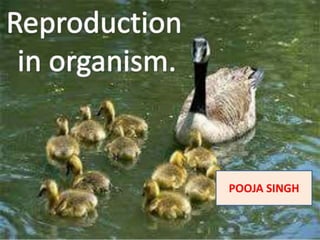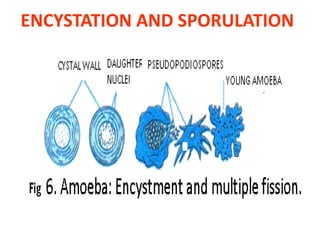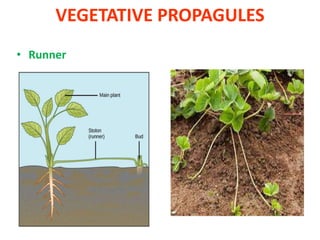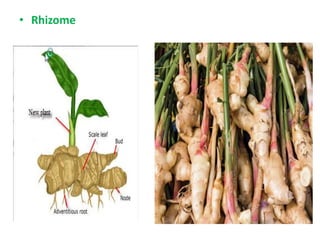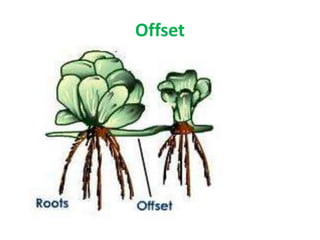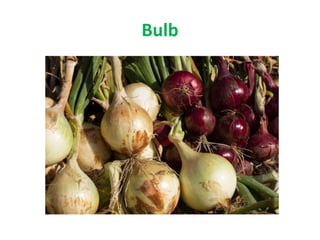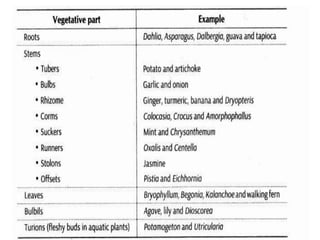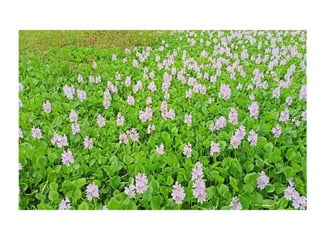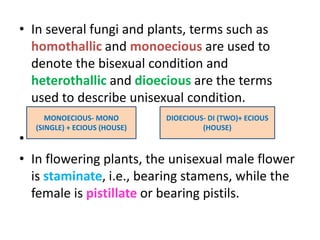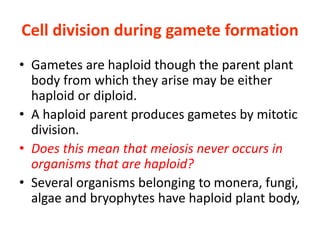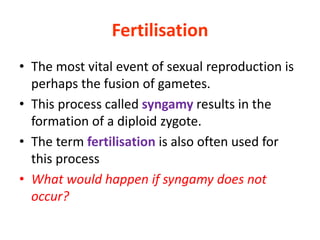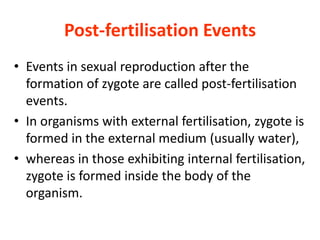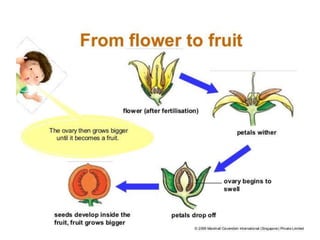Reproduction in organisms
- 1. POOJA SINGH
- 6. • Rhizome
- 7. • sucker
- 9. Tuber
- 10. Offset
- 11. Stolon v/s Offset • Long internodes • Give new plants • Short internodes • Give rosette( bunch of leaves)
- 12. Bulb
- 14. ‘water hyacinth’ ‘terror of Bengal’
- 17. SEXUAL REPRODUCTION • All organisms have to reach a certain stage of growth and maturity in their life, before they can reproduce sexually. • That period of growth is called the juvenile phase. • It is known as vegetative phase in plants.
- 18. • Annual Plants- are plants that germinate, flower, set seed, and die all in one season. • Example- Mustard, watermelon, corn, wheat • A biennial plant is a flowering plant that takes two years to complete its biological life cycle. • In the first year, the plant undergoes primary growth, in which its leaves, stems, and roots (vegetative structures) develop. • Next year, the plant then flowers, producing fruits and seeds before it finally dies • Example- Onion, Carrots, Cabbage
- 19. • Perennial Plants- especially small Flowering plants—that grow and bloom over the spring and summer, die back every autumn and winter, and then return in the spring from their rootstock. • Example- Strawberry, apple, pineapple, sweet potato. • Bamboo species flower only once in their life time, generally after 50-100 years, produce large number of fruits and die. • Strobilanthus kunthiana (neelakuranji), flowers once in 12 years.
- 20. SEXUAL REPRODUCTION Events in sexual reproduction • Sexual reproduction is characterised by the fusion (or fertilisation) of the male and female gametes, the formation of zygote and embryogenesis. • these sequential events may be grouped into three distinct stages namely, pre-fertilisation, fertilisation and post-fertilisation
- 21. Pre-fertilisation Events • Gametogenesis- refers to the process of formation of the two types of gametes – male and female. • Gametes are haploid cells
- 22. • In some algae the two gametes are so similar in appearance that it is not possible to categorise them into male and female gametes. • They are hence called homogametes (isogametes) • However, in a majority of sexually reproducing organisms the gametes produced are of two morphologically distinct types (heterogametes). • In such organisms the male gamete is called the antherozoid or sperm and the female gamete is called the egg or ovum
- 23. Sexuality in organisms • Sexual reproduction in organisms generally involves the fusion of gametes from two different individuals. • But this is not always true. • Plants may have both male and female reproductive structures in the same plant (bisexual) or on different plants (unisexual)
- 24. • In several fungi and plants, terms such as homothallic and monoecious are used to denote the bisexual condition and heterothallic and dioecious are the terms used to describe unisexual condition. • • In flowering plants, the unisexual male flower is staminate, i.e., bearing stamens, while the female is pistillate or bearing pistils. MONOECIOUS- MONO (SINGLE) + ECIOUS (HOUSE) DIOECIOUS- DI (TWO)+ ECIOUS (HOUSE)
- 25. • Are animals of all species either male or female (unisexual)? • Or are there species which possess both the reproductive organs (bisexual)?
- 26. • Earthworms, sponge, tapeworm and leech, typical examples of bisexual animals that possess both male and female reproductive organs, are hermaphrodites. • Cockroach is an example of a unisexual species Homothallic Monoecious Bisexual Hermaphrodites
- 27. Cell division during gamete formation • Gametes are haploid though the parent plant body from which they arise may be either haploid or diploid. • A haploid parent produces gametes by mitotic division. • Does this mean that meiosis never occurs in organisms that are haploid? • Several organisms belonging to monera, fungi, algae and bryophytes have haploid plant body,
- 28. • in organisms belonging to pteridophytes, gymnosperms, angiosperms and most of the animals including human beings, the parental body is diploid. • It is obvious that meiosis, the reduction division, has to occur if a diploid body has to produce haploid gametes.
- 29. • In diploid organisms, specialised cells called meiocytes (gamete mother cell) undergo meiosis. • At the end of meiosis, only one set of chromosomes gets incorporated into each gamete. Meiocytes 2N N N N N
- 30. Gamete Transfer • After their formation, male and female gametes must be physically brought together to facilitate fusion (fertilisation) • There is a need for a medium through which the male gametes move. • In several simple plants like algae, bryophytes and pteridophytes, water is the medium through which this gamete transfer takes place. • A large number of the male gametes, however, fail to reach the female gametes. • To compensate this loss of male gametes during transport, the number of male gametes produced is several thousand times the number of female gametes produced.
- 31. • In seed plants, pollen grains are the carriers of male gametes and ovule have the egg. • Pollen grains produced in anthers therefore, have to be transferred to the stigma before it can lead to fertilisation • In bisexual, self-fertilising plants, e.g., peas, transfer of pollen grains to the stigma is relatively easy as anthers and stigma are located close to each other; • pollen grains soon after they are shed, come in contact with the stigma.
- 32. • But in cross pollinating plants (including dioecious plants), a specialised event called pollination facilitates transfer of pollen grains to the stigma. • Pollen grains germinate on the stigma and the pollen tubes carrying the male gametes reach the ovule and discharge male gametes near the egg.
- 34. • In dioecious animals, since male and female gametes are formed in different individuals, the organism must evolve a special mechanism for gamete transfer. • Successful transfer and coming together of gametes is essential for the most critical event in sexual reproduction, the fertilisation.
- 35. Fertilisation • The most vital event of sexual reproduction is perhaps the fusion of gametes. • This process called syngamy results in the formation of a diploid zygote. • The term fertilisation is also often used for this process • What would happen if syngamy does not occur?
- 36. • However, it has to be mentioned here that in some organisms like rotifers, honeybees and even some lizards and birds (turkey), the female gamete undergoes development to form new organisms without fertilisation. • This phenomenon is called parthenogenesis.
- 37. Where does syngamy occur? • In most aquatic organisms, such as a majority of algae and fishes as well as amphibians, syngamy occurs in the external medium (water), i.e., outside the body of the organism. • This type of gametic fusion is called external fertilisation.
- 38. • Organisms exhibiting external fertilisation show great synchrony between the sexes and release a large number of gametes into the surrounding medium (water) in order to enhance the chances of syngamy. • This happens in the bony fishes and frogs where a large number of offspring are produced. • A major disadvantage is that the offspring are extremely vulnerable to predators threatening their survival up to adulthood.
- 39. • In many terrestrial organisms, belonging to fungi, higher animals such as • reptiles, birds, mammals and in a majority of plants (bryophytes, pteridophytes, gymnosperms and angiosperms), • syngamy occurs inside the body of the organism, hence the process is called internal fertilisation.
- 40. • In all these organisms, egg is formed inside the female body where they fuse with the male gamete. • In organisms exhibiting internal fertilisation, the male gamete is motile and has to reach the egg in order to fuse with it. • In these even though the number of sperms produced is very large, there is a significant reduction in the number of eggs produced. • In seed plants, however, the non-motile male gametes are carried to female gamete by pollen tubes.
- 42. Post-fertilisation Events • Events in sexual reproduction after the formation of zygote are called post-fertilisation events. • In organisms with external fertilisation, zygote is formed in the external medium (usually water), • whereas in those exhibiting internal fertilisation, zygote is formed inside the body of the organism.
- 43. • Further development of the zygote depends on the type of life cycle the organism has and the environment it is exposed to. • In organisms belonging to fungi and algae, zygote develops a thick wall that is resistant to dessication and damage. • It undergoes a period of rest before germination • In organisms with haplontic life cycle, zygote divides by meiosis to form haploid spores that grow into haploid individuals
- 44. Sperm 23 Egg 23 Zygote 46 23 23 23 23 46 46 Mitosis (humans) Meiosis (algae, honeybee)
- 47. Embryogenesis • Embryogenesis refers to the process of development of embryo from the zygote. • During embryogenesis, zygote undergoes cell division (mitosis) and cell differentiation. • While cell divisions increase the number of cells in the developing embryo; cell differentiation helps groups of cells to undergo certain modifications to form specialised tissues and organs to form an organism.
- 48. • Animals are categorised into oviparous and viviparous based on whether the development of the zygote takes place outside the body of the female parent or inside, i.e., whether they lay fertilised/unfertilised eggs or give birth to young ones
- 49. • Oviparous- those animals which lay eggs whether fertilized or unfertilized. • Viviparous- give birth to young ones.
- 50. • In oviparous animals like reptiles and birds, the fertilised eggs covered by hard calcareous shell are laid in a safe place in the environment; after a period of incubation young ones hatch out. • On the other hand, in viviparous animals (majority of mammals including human beings), the zygote develops into a young one inside the body of the female organism. • After attaining a certain stage of growth, the young ones are delivered out of the body of the female organism. • Because of proper embryonic care and protection, the chances of survival of young ones is greater in viviparous organisms.
- 51. • In flowering plants, the zygote is formed inside the ovule. • After fertilisation the sepals, petals and stamens of the flower wither and fall off. • Can you name a plant in which the sepals remain attached? • The pistil however, remains attached to the plant. • The zygote develops into the embryo and the ovules develop into the seed. • The ovary develops into the fruit which develops a thick wall called pericarp that is protective in function • After dispersal, seeds germinate under favourable conditions to produce new plants.
